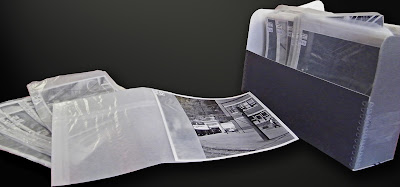 |
| Just one of the several boxes of Cominco photos gathered by their Kimberley Operations |
Starting in ca 1910, shortly after the
Sullivan Mine was opened here in Kimberley, BC, the mine owners began collecting photos of
the whole operation. These photos were
used for such things as advertizing, personnel and community relations, communications about machinery repair, and
much more.
By the time the mine closed in December
2001, a vast collection of official company photos had been amassed. Most were stored at Cominco’s Kimberley Office
on Howard Street and some were kept in Trail and various other company locations. When the Kimberley Office was closed, Teck
Cominco kindly donated the older photos to the BC Archives and the more recent
photos to the Kimberley Heritage Museum.
The Museum received 5,217 photos of Kimberley
Operations, making this the largest photo collection from a single donor archived
here at the Museum.
Organizing these thousands of photos
required a person with intimate knowledge of the mine’s layout, it’s workings,
it’s employees, their daily activities and special events. Who are the people
in the photos? Where exactly in the mine was this photo taken? What is that
machine? Which part of the Kimberley Operations does this depict – the mine
itself, the mill, the fertilizer plant, the tin plant ... ? What special or community event is this? And
so on.
 |
| Brian Crowe, miner and historian, holding an original photo depicting the workings deep in the Sullivan Mine |
The task of describing, categorizing, and registering a photo in the Museum’s catalogue fell to a person most qualified to do the
job, Museum Director Brian Crowe – himself a miner in the Sullivan for 32
years, and the son of George Crowe who served as a mine foreman for 37 years.
As a technician in the Geology Department, Mr. Crowe visited every
corner of the mine. One of their jobs was to determine the fate of the recently blasted
ore (called ‘muck’) now lying in a heap on the tunnel floor. If the muck had
high enough concentrations of sought-after minerals to make it worth processing,
it went to the Mill to be broken up in smaller pieces then shipped by rail to
the Smelter in Trail, BC. If not, it
went to the ‘waste rock’ pile or was used to back-fill tunnels and raises
(vertical tunnels). They could tell if the ore was economical usually by just looking at it!
Mr. Crowe worked on describing and
organizing the thousands of photos every work day for 7 months.
 |
| Galena - Sullivan ore, on sale at the Museum |
The Museum’s collection of Cominco photos is now easily searchable!
Now we can easily tell if we have a photo of
a certain subject or person, for example, by looking at the digital or the
printed copy of the finding aid.
 |
| Summer student, Allanah, compiling the descriptions to create a 'finding aid' - July 2012 |
Some of the subjects in the collection are as follows:
Community areas and buildings
Community events and organizations
Personnel
Retirees and events
Sports teams and events
Wildlife
Local landscapes
Machinery
Mining and processing locations
If you are searching for a photo that may
be in this collection, the Museum advises that you first check the website of
The Columbia Basin Institute of Regional History, which has some of the photos
and an online ordering system for prints.
